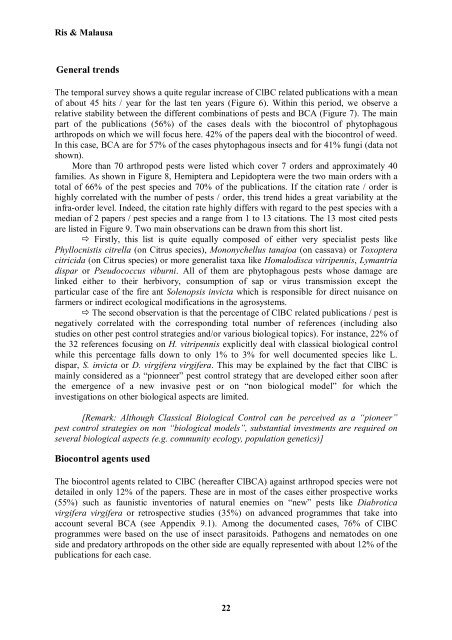Classical and augmentative biological control against ... - IOBC-WPRS
Classical and augmentative biological control against ... - IOBC-WPRS
Classical and augmentative biological control against ... - IOBC-WPRS
Create successful ePaper yourself
Turn your PDF publications into a flip-book with our unique Google optimized e-Paper software.
Ris & Malausa<br />
General trends<br />
The temporal survey shows a quite regular increase of ClBC related publications with a mean<br />
of about 45 hits / year for the last ten years (Figure 6). Within this period, we observe a<br />
relative stability between the different combinations of pests <strong>and</strong> BCA (Figure 7). The main<br />
part of the publications (56%) of the cases deals with the bio<strong>control</strong> of phytophagous<br />
arthropods on which we will focus here. 42% of the papers deal with the bio<strong>control</strong> of weed.<br />
In this case, BCA are for 57% of the cases phytophagous insects <strong>and</strong> for 41% fungi (data not<br />
shown).<br />
More than 70 arthropod pests were listed which cover 7 orders <strong>and</strong> approximately 40<br />
families. As shown in Figure 8, Hemiptera <strong>and</strong> Lepidoptera were the two main orders with a<br />
total of 66% of the pest species <strong>and</strong> 70% of the publications. If the citation rate / order is<br />
highly correlated with the number of pests / order, this trend hides a great variability at the<br />
infra-order level. Indeed, the citation rate highly differs with regard to the pest species with a<br />
median of 2 papers / pest species <strong>and</strong> a range from 1 to 13 citations. The 13 most cited pests<br />
are listed in Figure 9. Two main observations can be drawn from this short list.<br />
Firstly, this list is quite equally composed of either very specialist pests like<br />
Phyllocnistis citrella (on Citrus species), Mononychellus tanajoa (on cassava) or Toxoptera<br />
citricida (on Citrus species) or more generalist taxa like Homalodisca vitripennis, Lymantria<br />
dispar or Pseudococcus viburni. All of them are phytophagous pests whose damage are<br />
linked either to their herbivory, consumption of sap or virus transmission except the<br />
particular case of the fire ant Solenopsis invicta which is responsible for direct nuisance on<br />
farmers or indirect ecological modifications in the agrosystems.<br />
The second observation is that the percentage of ClBC related publications / pest is<br />
negatively correlated with the corresponding total number of references (including also<br />
studies on other pest <strong>control</strong> strategies <strong>and</strong>/or various <strong>biological</strong> topics). For instance, 22% of<br />
the 32 references focusing on H. vitripennis explicitly deal with classical <strong>biological</strong> <strong>control</strong><br />
while this percentage falls down to only 1% to 3% for well documented species like L.<br />
dispar, S. invicta or D. virgifera virgifera. This may be explained by the fact that ClBC is<br />
mainly considered as a “pionneer” pest <strong>control</strong> strategy that are developed either soon after<br />
the emergence of a new invasive pest or on “non <strong>biological</strong> model” for which the<br />
investigations on other <strong>biological</strong> aspects are limited.<br />
[Remark: Although <strong>Classical</strong> Biological Control can be perceived as a “pioneer”<br />
pest <strong>control</strong> strategies on non “<strong>biological</strong> models”, substantial investments are required on<br />
several <strong>biological</strong> aspects (e.g. community ecology, population genetics)]<br />
Bio<strong>control</strong> agents used<br />
The bio<strong>control</strong> agents related to ClBC (hereafter ClBCA) <strong>against</strong> arthropod species were not<br />
detailed in only 12% of the papers. These are in most of the cases either prospective works<br />
(55%) such as faunistic inventories of natural enemies on “new” pests like Diabrotica<br />
virgifera virgifera or retrospective studies (35%) on advanced programmes that take into<br />
account several BCA (see Appendix 9.1). Among the documented cases, 76% of ClBC<br />
programmes were based on the use of insect parasitoids. Pathogens <strong>and</strong> nematodes on one<br />
side <strong>and</strong> predatory arthropods on the other side are equally represented with about 12% of the<br />
publications for each case.<br />
22

















